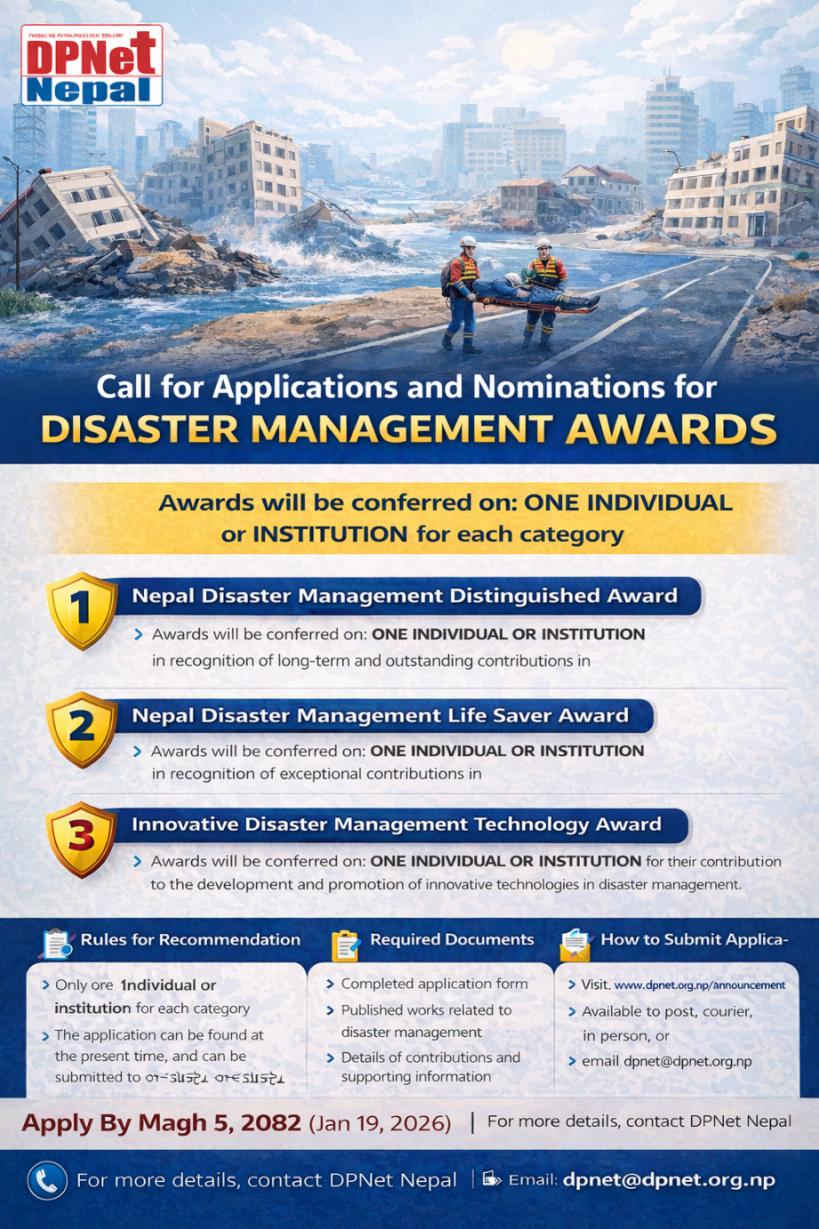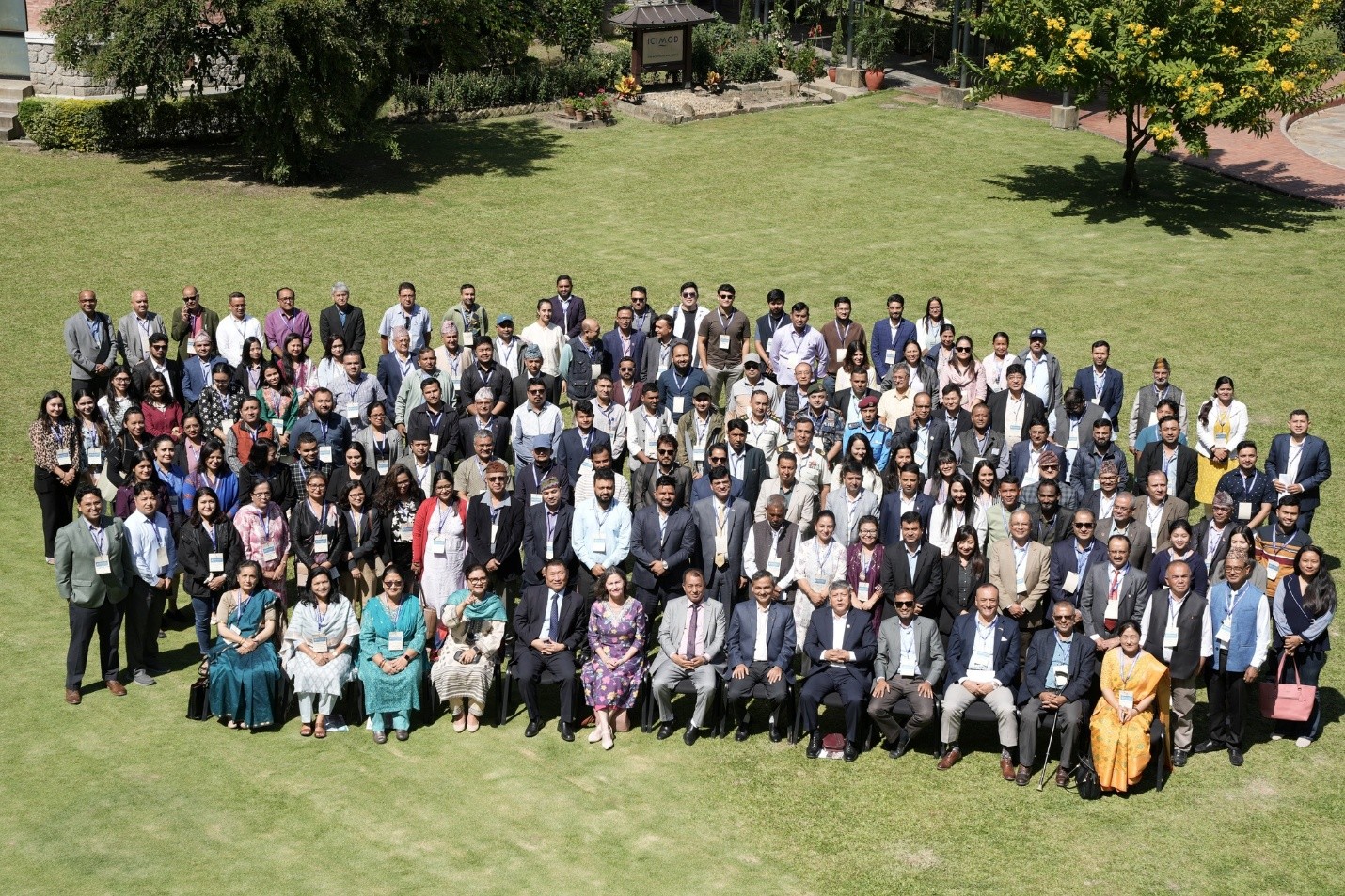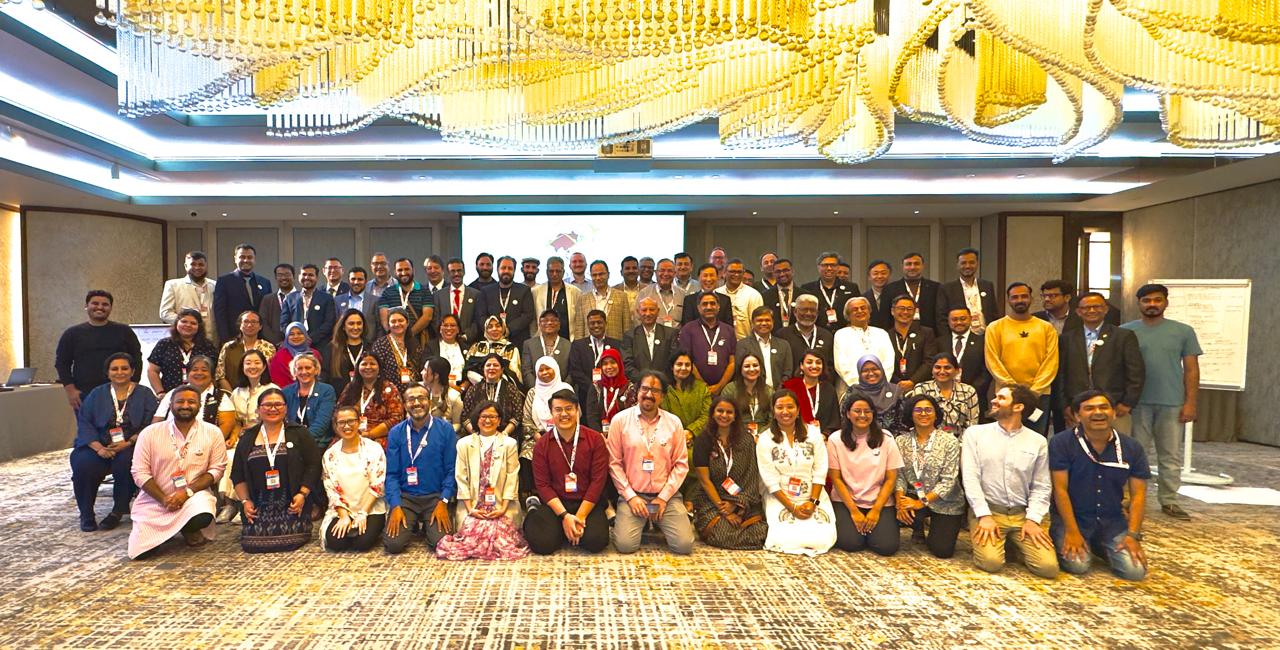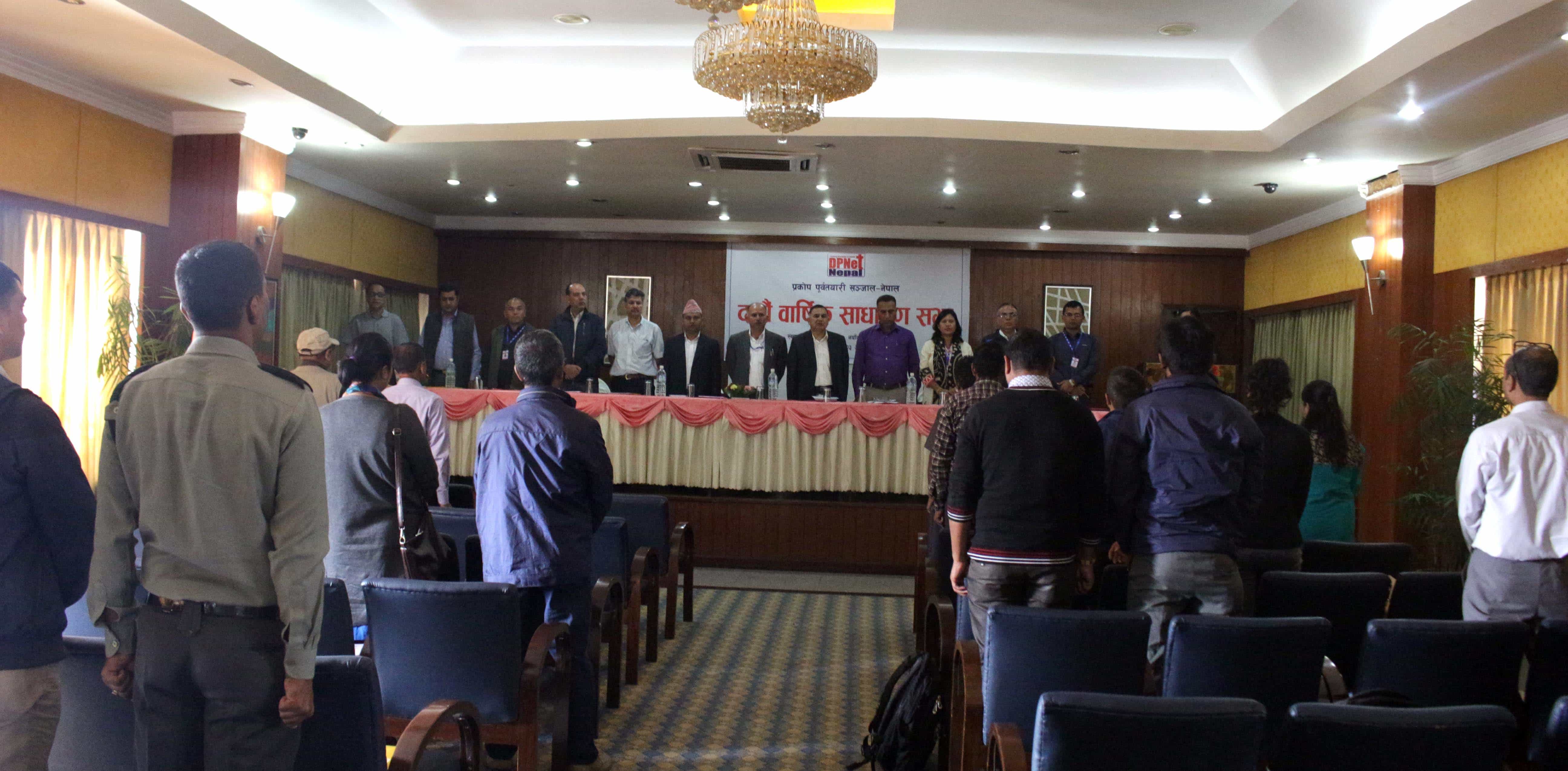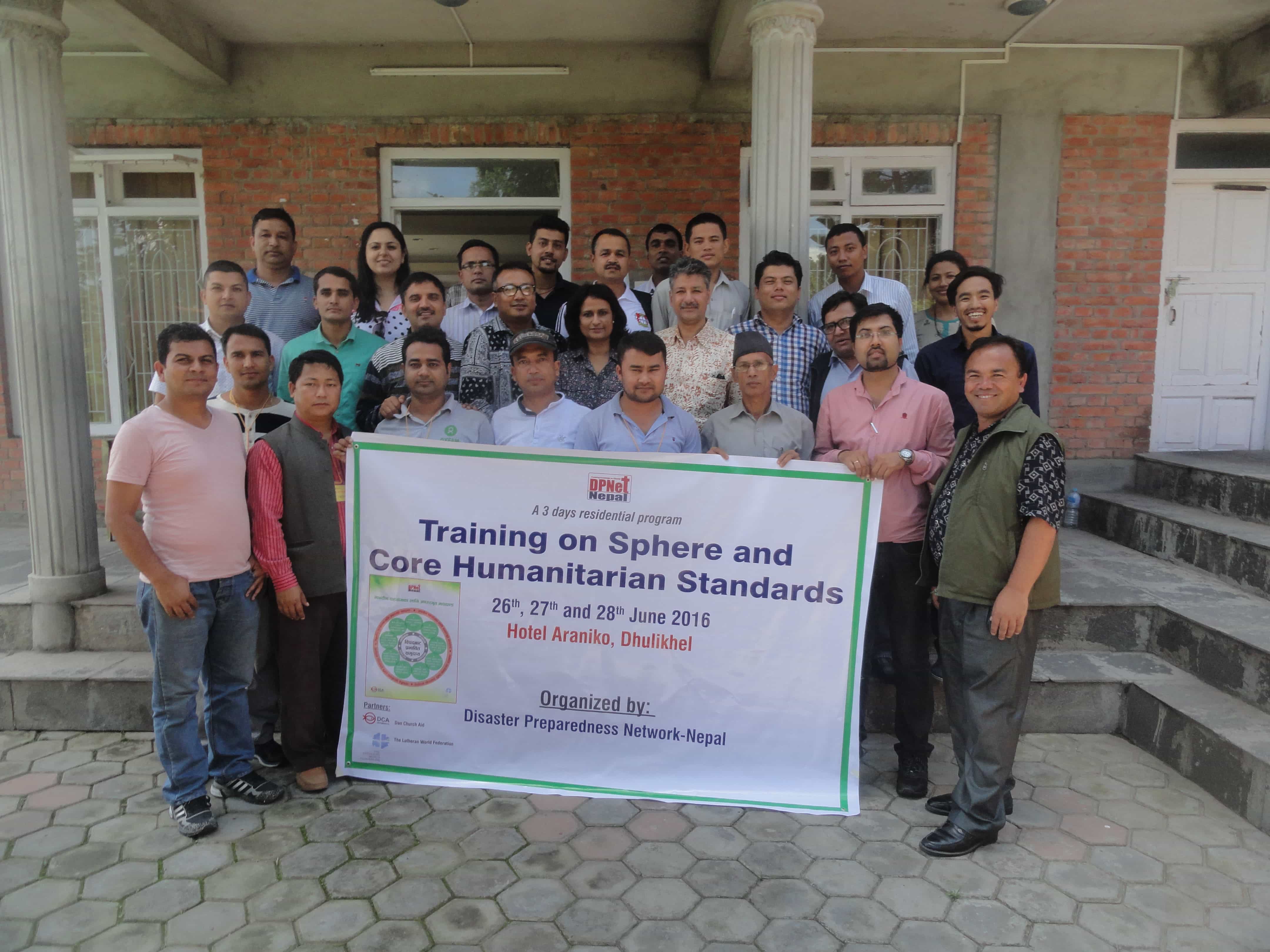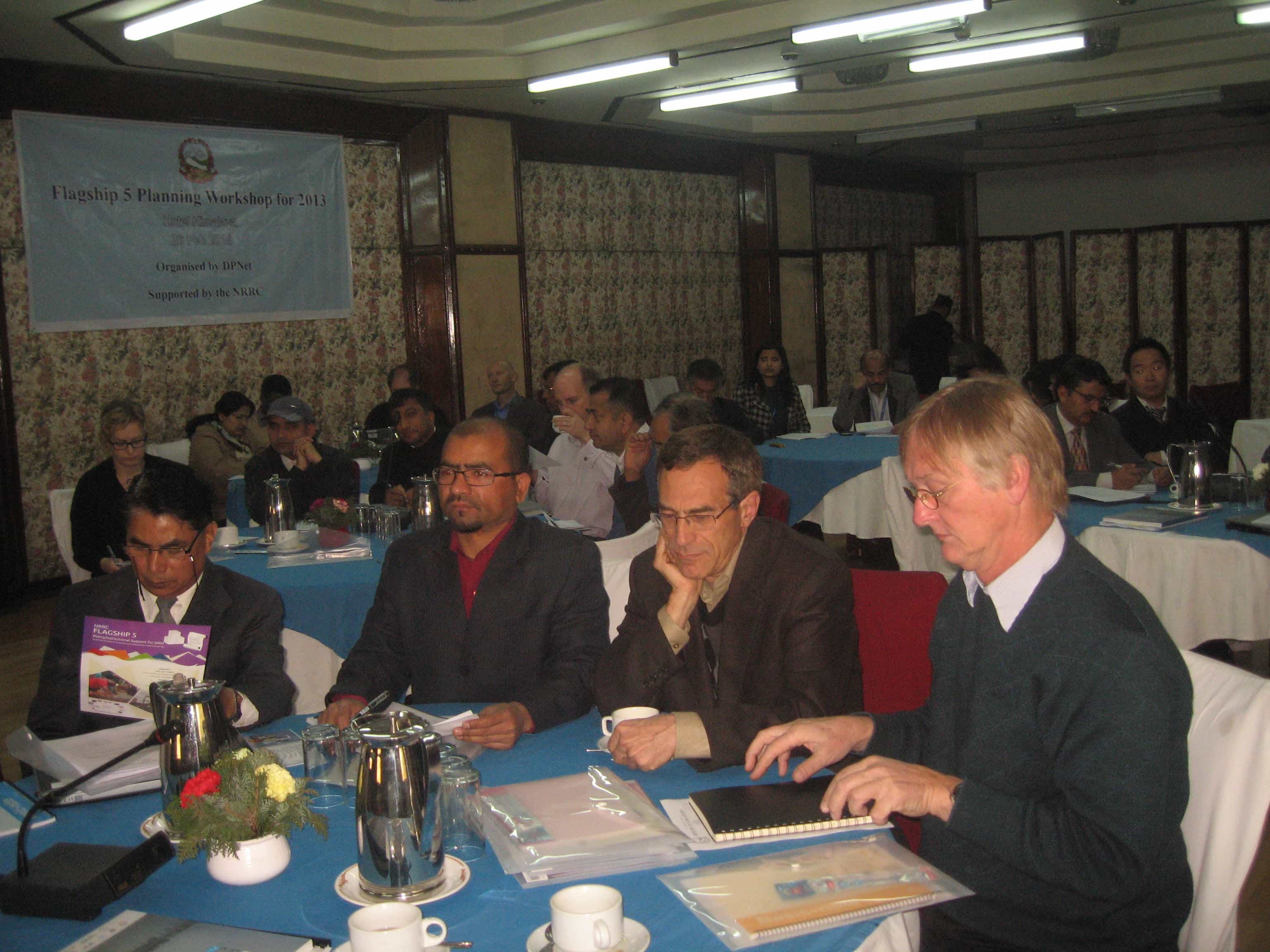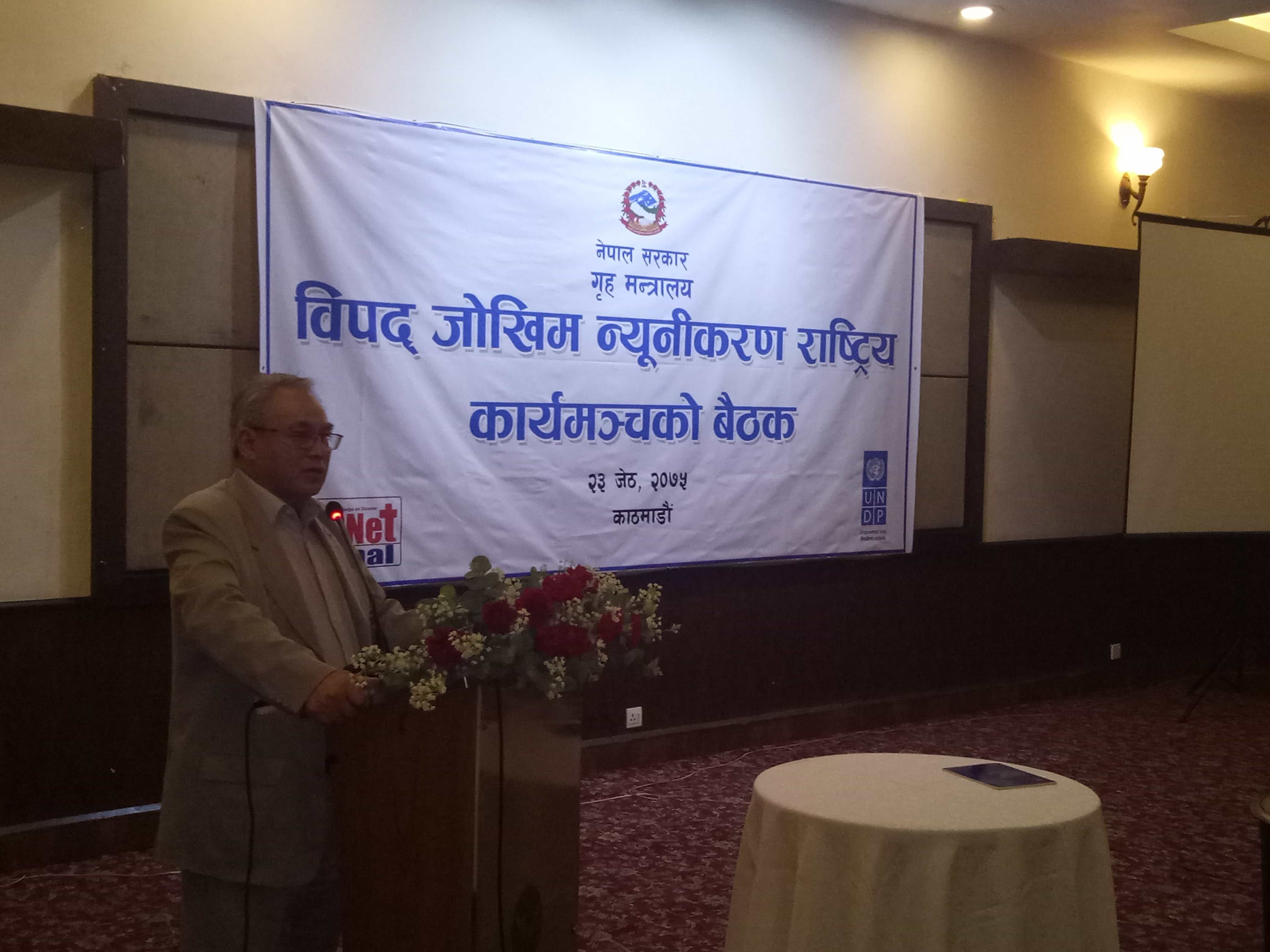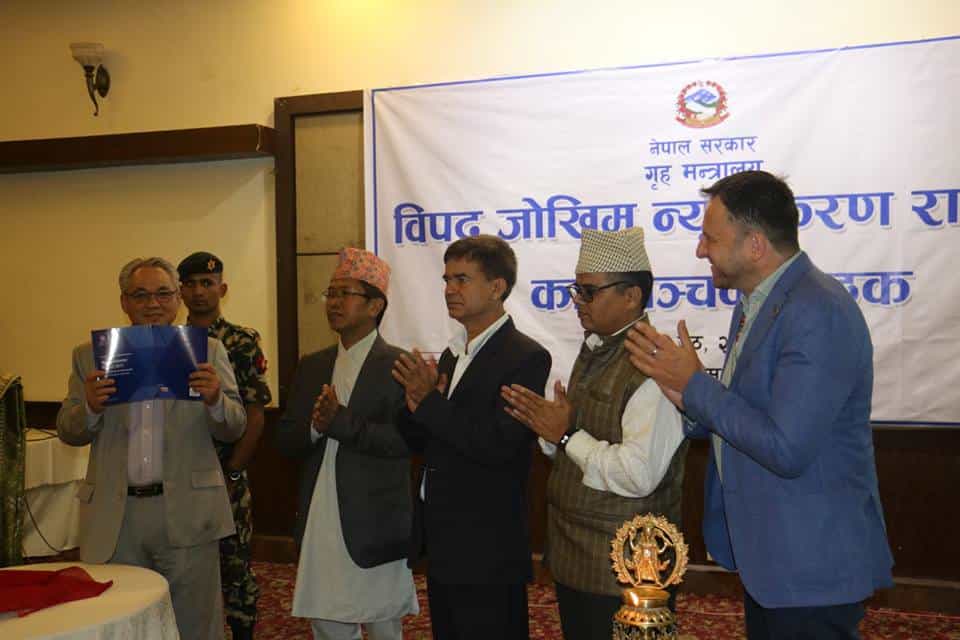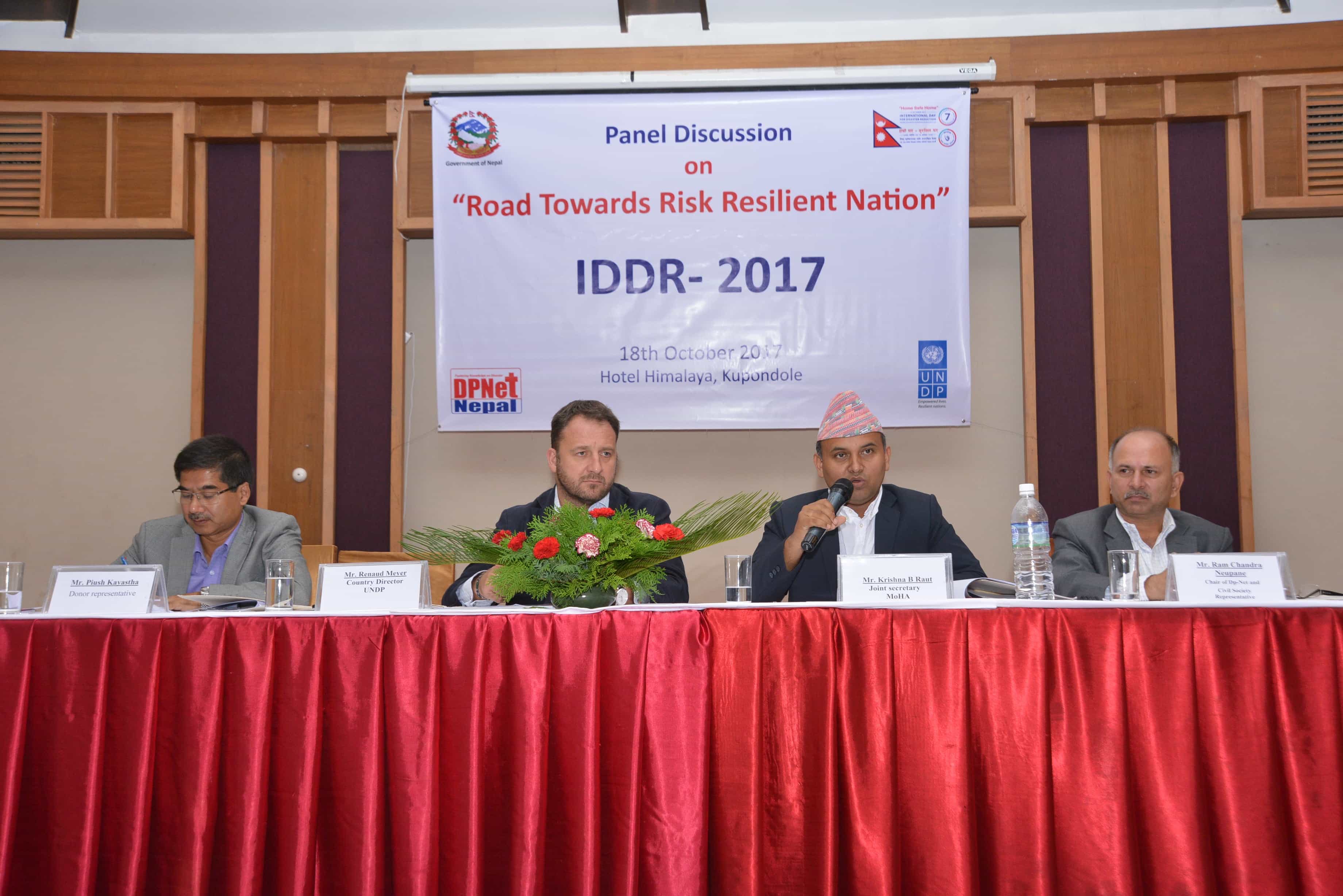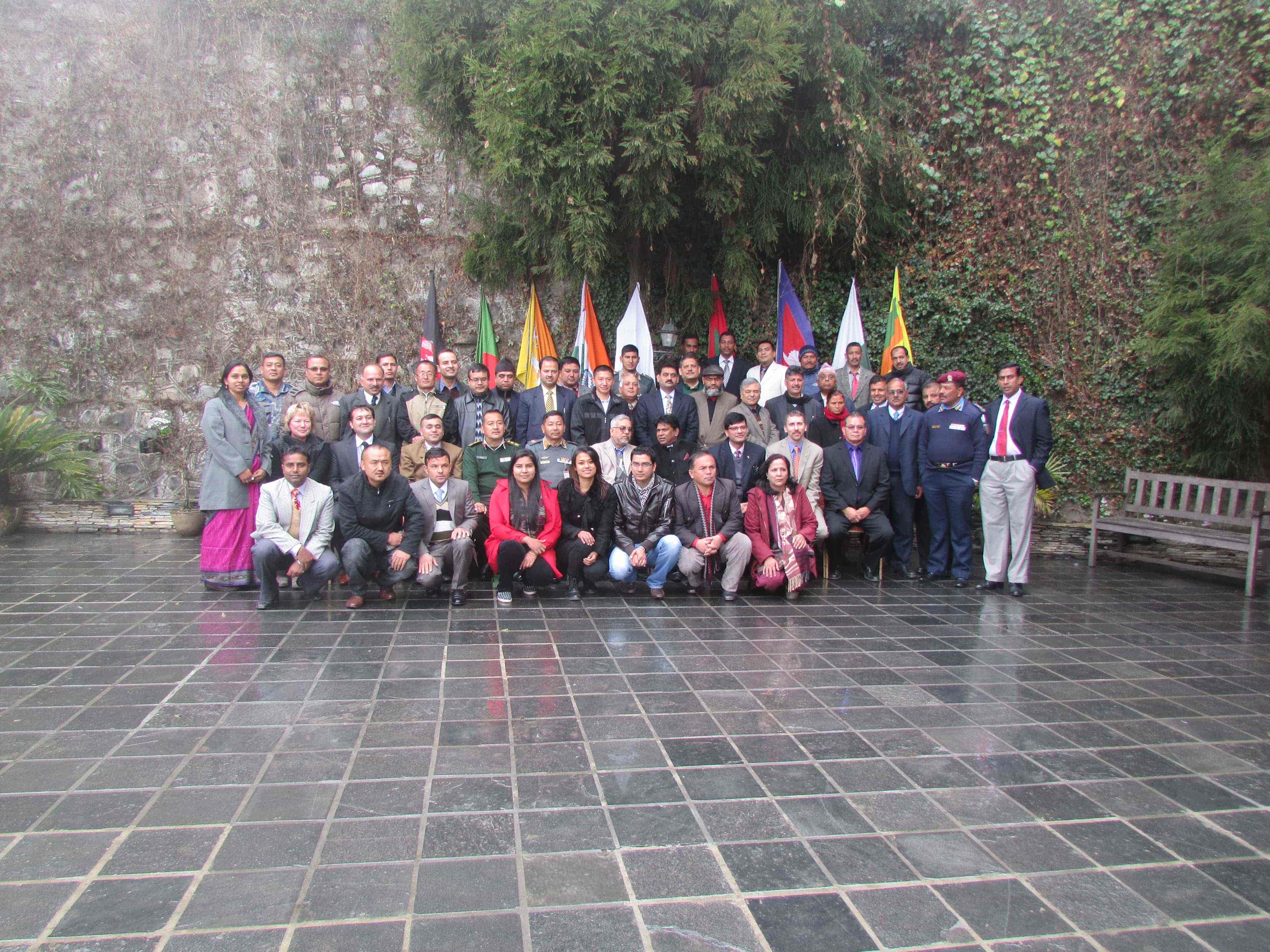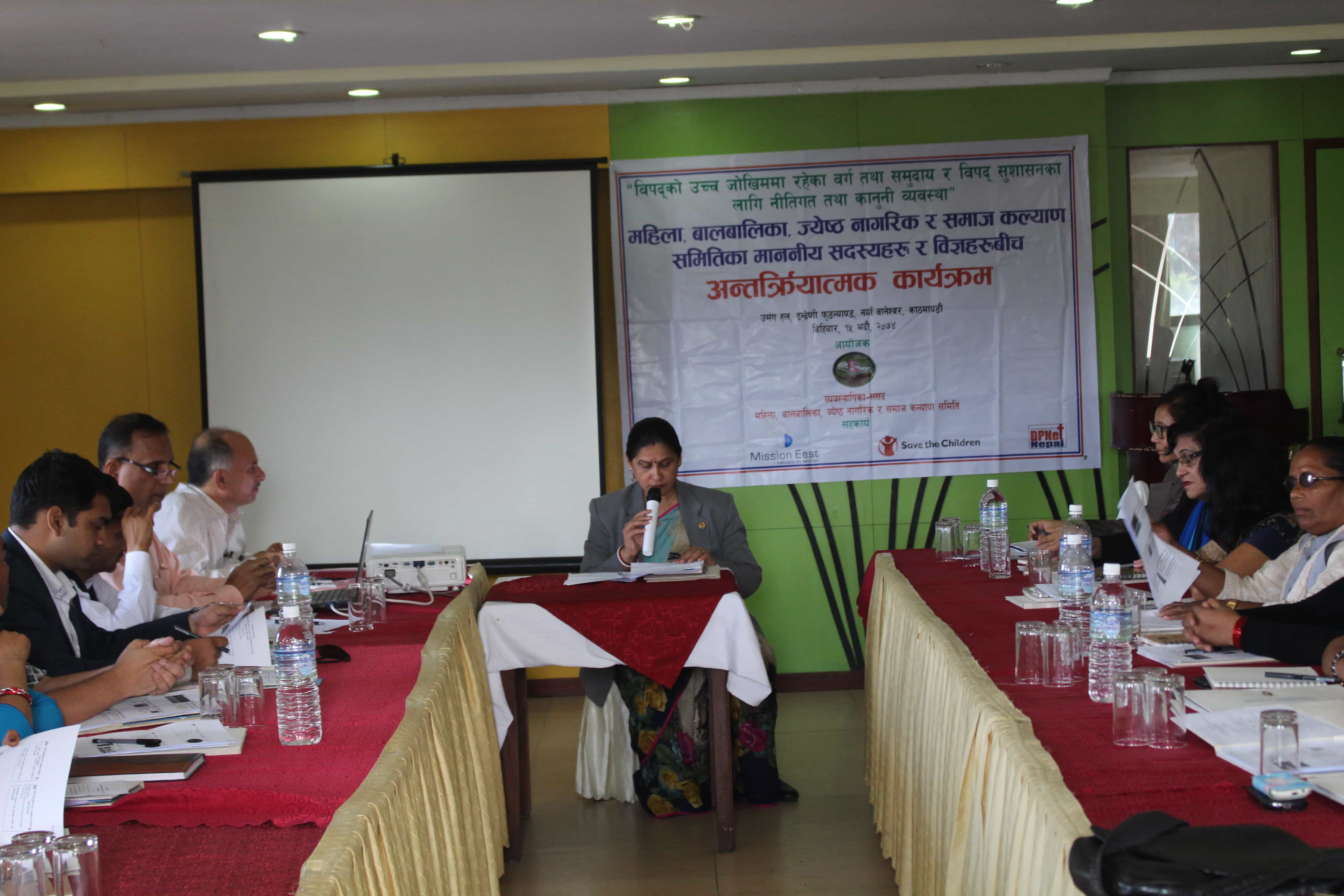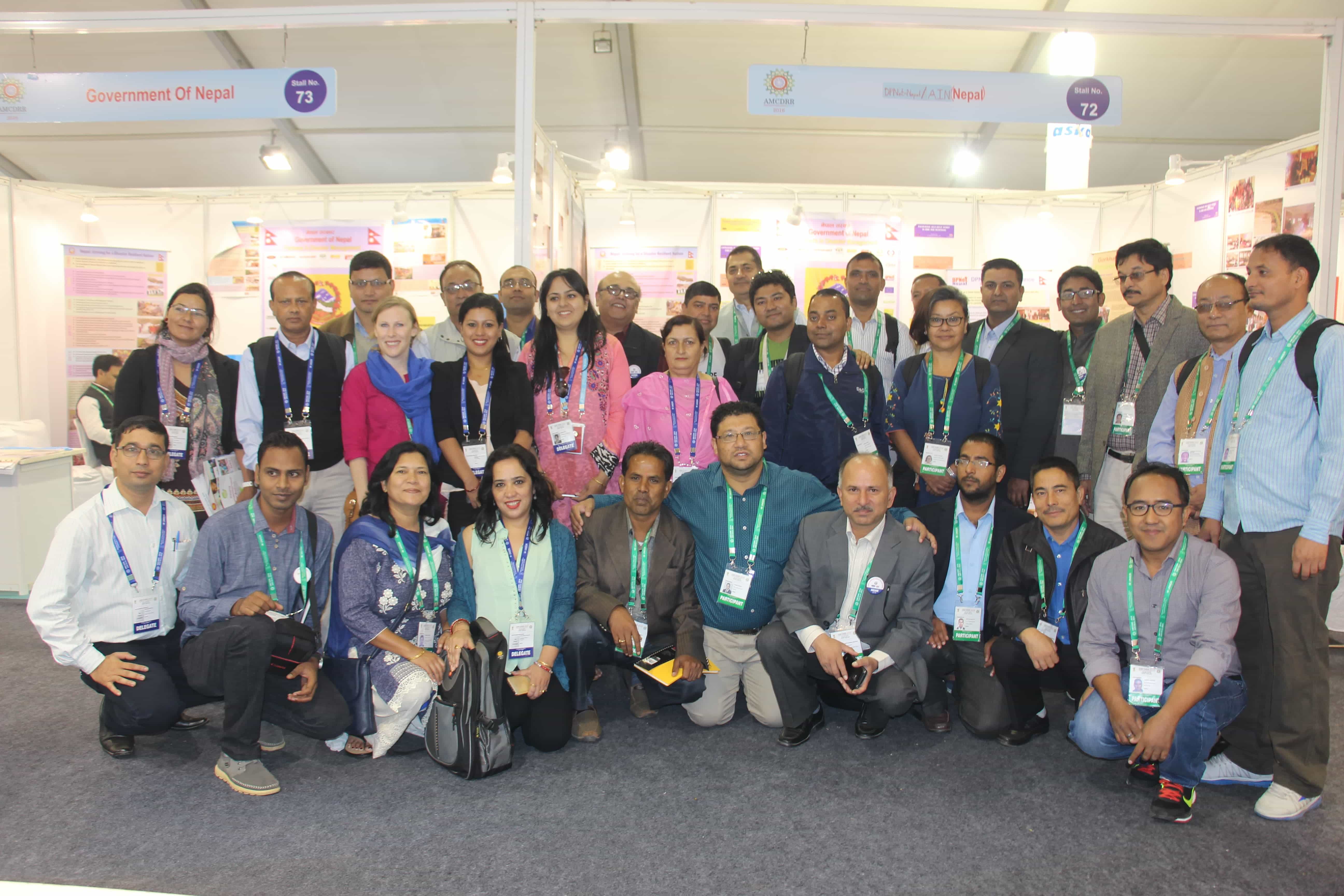GPDRR Position Paper Discussion Program
May 11, 2022
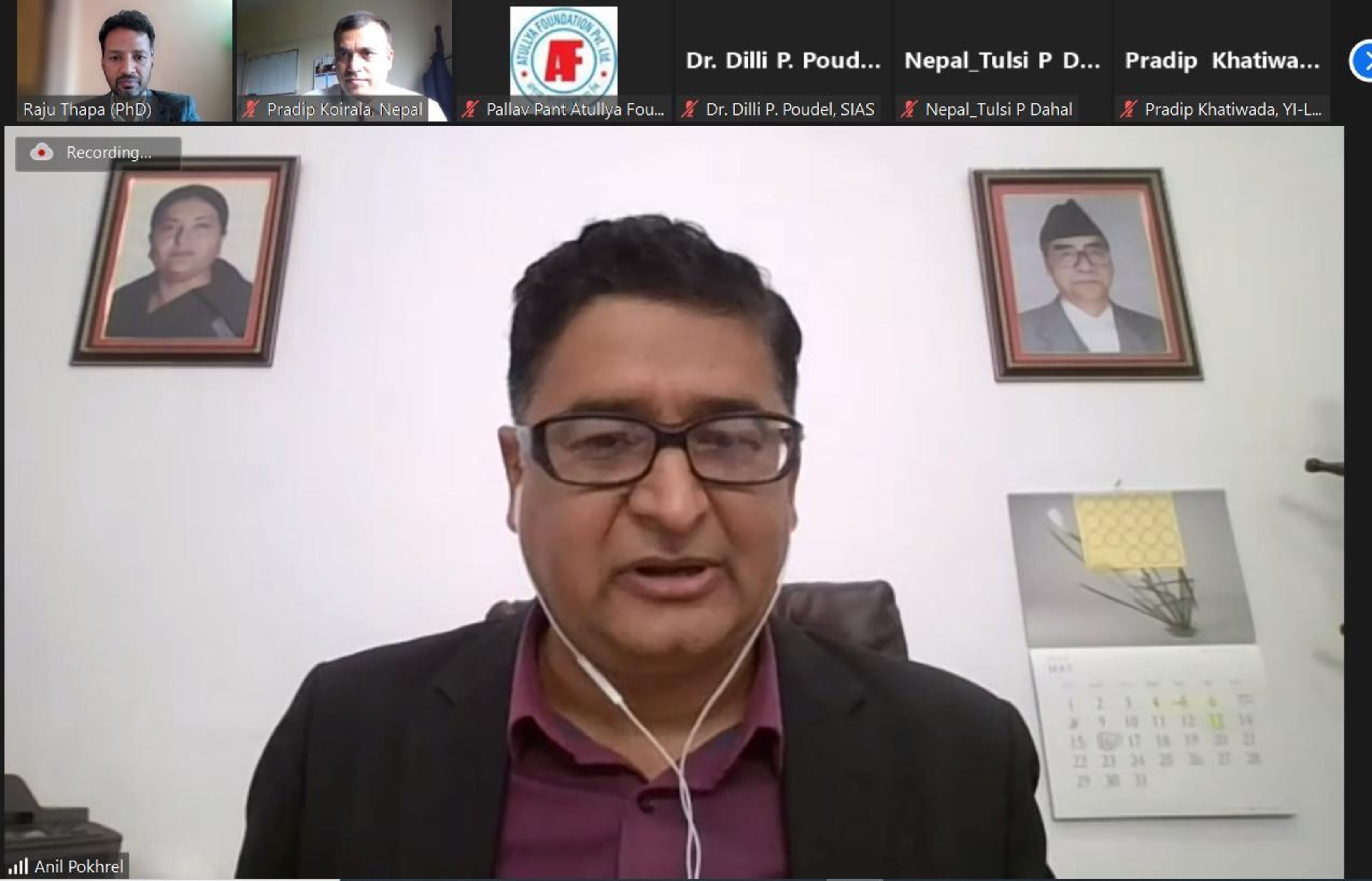
The virtual discussion program on Zero Draft GPDRR Position Paper organized by DPNet on 11th May, 2022. The zero draft position paper was prepared by Mr. Gehendra Gurung in support of GPDRR Preparatory Task Group. The program was attended by 62 participants including Mr. Anil Pokhrel, Executive Chief of National Disaster Risk Reduction and Management Authority (NDRRMA), Mr. Pradip Kumar Koirala, Chief of Disaster and Conflict Management Division Ministry of Home Affairs (MoHA), representatives of NPDRR thematic group, various DRRM stakeholders and experts
Major Highlights:
Dr. Raju Thapa, Acting Chair of DPNet (Program Facilitator)
The official statement was finalized with the help of many stakeholders under the supervision of MoHA and NDRRMA and formally uploaded in the GPDRR system on 1st May, 2022. This zero draft position paper is the elaborated form of the same official statement. When Nepal participates in global platforms, it usually shares a position paper. In order to have a wider ownership, DPNet as a Secretariat of NPDRR coordinates all DRRM stakeholders, bringing them in a wider meeting to sort out contentious issues to prepare a widely accepted position paper.
Mr. Gehendra Gurung shared the zero draft position paper
The zero draft position paper was the elaborated form of official statement and the past experience of position paper which included various GPDRR themes. Beside this while developing the position paper, conclusion of first historic National Conference on Disaster Risk Reduction (NCDRR) and GPDRR theme were also taken into consideration. The draft tried to give the glimpseNepal disaster vulnerability that includes hazard, exposure, vulnerability, loss and damages, economic loss was classified by economic loss, hazard wise economic loss, vulnerable groups, age group, house damages, number of incidents and total number of deaths occurred by various disasters in graphs.
The position paper comprises of the status of Nepal in pandemic response, its learning, risk informed development, policy and legal frameworks development, risk governance, information communication and dissemination, investing in disaster management, response in build back better, about the synergy between disaster risk reduction, climate actions and sustainable development goals and leaving no one behind approach.
The paper centered no one leave behind principle emphasizing the challenges in disaster management and the way forward
Open discussion and comments
Ms. Chadani Joshi,
The paper was drafted with a lot of comprehensiveness and thoughtfulness with good studies and best practices. While representing Nepal in such platforms it should go in a holistic way. To make this paper many realistic things have been added such as SDG, leaving no one behind, Sendai Framework and so on but this paper seems gender neutral. Women’s issues should be cooperated in existing scenarios and a way forward for both. Disaster’s impact is different in women and men. We follow ‘no one leaving behind’ so it’s very important to understand that women, girls, minors, disable people are highly vulnerable and need to be included in mitigation. Further, we need to focus on reconstruction, rehabilitation, recovery along with rescue and relief. The examples of positive changes in plans, policies and acts should also be included.
Mr. Nilkantha Pandey
The structure of the report should be updated to be reader friendly. Each six thematic areas, its key achievements in terms of policy and actions, its progress in terms of gender responsiveness and inclusiveness, its challenges and way forward should be separately managed.
Dr. Dharam Uprety
We should be clear about what we are keeping in the international platforms. The key achievement of Nepal ought to be included in the position paper. Risk transfer mechanisms, risk finance mechanisms, anticipatory action should have good space in the paper.
Mr. Amrit Sharma
We need to focus on the consistency of the document. The climate induced disaster should also be on priority list. We need to invest in data generation to justify our work.
Mr. Ram Prasad Bhandari
The challenges and way forward are realistic but we should not over praise our work. Risk informed development is included both in gaps and strong points, this should be clarified. Attention should be given to target international audiences who are not familiar with Nepali context.
Ms. Durga Sob
Women’s perspectives should be highlighted. Disaster affects individuals differently, so diversity perspectives should be enhanced and elaborated. Marginalized community’s voice must be addressed.
Mr. Pradip Khatiwada
Youth contribution in various disasters including 2015 earthquake, flood, COVID pandemic should be highlighted and our progressive achievement in disaster information management system should be reflected somewhere.
Ms. Renu
Dalit and marginalized community, women and disable community should be identified. Good innovations should be included in the way forward.
Ms. Rajin Rayamajhi
We are working more on response but there is a lack of preparedness. Youth, women groups and communities that worked in pandemic need to be addressed.
Mr. Deepak Paudel
We have to go forward in an ecosystem wise approach. We have a strong early warning system, so if there are any gaps it needs to be solved but our achievement in this field should be reflected. As Local Governments are the first responder, our effort to strengthen their capacity should be reflected.
Dr. Dilli Prasad Poudel
We have to focus on challenges such as poor coordination. COVID section is quite more, and needs to be summarized.
Major Highlights:
Dr. Raju Thapa, Acting Chair of DPNet (Program Facilitator)
The official statement was finalized with the help of many stakeholders under the supervision of MoHA and NDRRMA and formally uploaded in the GPDRR system on 1st May, 2022. This zero draft position paper is the elaborated form of the same official statement. When Nepal participates in global platforms, it usually shares a position paper. In order to have a wider ownership, DPNet as a Secretariat of NPDRR coordinates all DRRM stakeholders, bringing them in a wider meeting to sort out contentious issues to prepare a widely accepted position paper.
Mr. Gehendra Gurung shared the zero draft position paper
The zero draft position paper was the elaborated form of official statement and the past experience of position paper which included various GPDRR themes. Beside this while developing the position paper, conclusion of first historic National Conference on Disaster Risk Reduction (NCDRR) and GPDRR theme were also taken into consideration. The draft tried to give the glimpseNepal disaster vulnerability that includes hazard, exposure, vulnerability, loss and damages, economic loss was classified by economic loss, hazard wise economic loss, vulnerable groups, age group, house damages, number of incidents and total number of deaths occurred by various disasters in graphs.
The position paper comprises of the status of Nepal in pandemic response, its learning, risk informed development, policy and legal frameworks development, risk governance, information communication and dissemination, investing in disaster management, response in build back better, about the synergy between disaster risk reduction, climate actions and sustainable development goals and leaving no one behind approach.
The paper centered no one leave behind principle emphasizing the challenges in disaster management and the way forward
Open discussion and comments
Ms. Chadani Joshi,
The paper was drafted with a lot of comprehensiveness and thoughtfulness with good studies and best practices. While representing Nepal in such platforms it should go in a holistic way. To make this paper many realistic things have been added such as SDG, leaving no one behind, Sendai Framework and so on but this paper seems gender neutral. Women’s issues should be cooperated in existing scenarios and a way forward for both. Disaster’s impact is different in women and men. We follow ‘no one leaving behind’ so it’s very important to understand that women, girls, minors, disable people are highly vulnerable and need to be included in mitigation. Further, we need to focus on reconstruction, rehabilitation, recovery along with rescue and relief. The examples of positive changes in plans, policies and acts should also be included.
Mr. Nilkantha Pandey
The structure of the report should be updated to be reader friendly. Each six thematic areas, its key achievements in terms of policy and actions, its progress in terms of gender responsiveness and inclusiveness, its challenges and way forward should be separately managed.
Dr. Dharam Uprety
We should be clear about what we are keeping in the international platforms. The key achievement of Nepal ought to be included in the position paper. Risk transfer mechanisms, risk finance mechanisms, anticipatory action should have good space in the paper.
Mr. Amrit Sharma
We need to focus on the consistency of the document. The climate induced disaster should also be on priority list. We need to invest in data generation to justify our work.
Mr. Ram Prasad Bhandari
The challenges and way forward are realistic but we should not over praise our work. Risk informed development is included both in gaps and strong points, this should be clarified. Attention should be given to target international audiences who are not familiar with Nepali context.
Ms. Durga Sob
Women’s perspectives should be highlighted. Disaster affects individuals differently, so diversity perspectives should be enhanced and elaborated. Marginalized community’s voice must be addressed.
Mr. Pradip Khatiwada
Youth contribution in various disasters including 2015 earthquake, flood, COVID pandemic should be highlighted and our progressive achievement in disaster information management system should be reflected somewhere.
Ms. Renu
Dalit and marginalized community, women and disable community should be identified. Good innovations should be included in the way forward.
Ms. Rajin Rayamajhi
We are working more on response but there is a lack of preparedness. Youth, women groups and communities that worked in pandemic need to be addressed.
Mr. Deepak Paudel
We have to go forward in an ecosystem wise approach. We have a strong early warning system, so if there are any gaps it needs to be solved but our achievement in this field should be reflected. As Local Governments are the first responder, our effort to strengthen their capacity should be reflected.
Dr. Dilli Prasad Poudel
We have to focus on challenges such as poor coordination. COVID section is quite more, and needs to be summarized.
Mr. Tulsi Prasad Dahal
There should also be focus on urban fire management. Policy legal framework and DRR governance should be merged.Promulgation of DRRM policy is not a duty of a single government institution so DRRM policy formulation process should not be misguided. It would be better to highlight the climate funds to work on climate induced disasters in the forum. The earthquake safety day, DRR day celebration and other messaging campaigns need to be highlighted. The challenges and way forward should be harmonized.
After collecting the feedback from various stakeholders, meeting decided to formed seven-member committee comprising Ms. Chandani Joshi, Mr. Ram Prasad Bhandari, Mr. Dinanath Bhandai, Mr. Tulsi Prasad Dahal, Mr. Sajan Neupane, Dr. Dharam Raj Uprety and Mr. Nilkantha Pandey to finalize and refine the position paper.
Other comments:
There should also be focus on urban fire management. Policy legal framework and DRR governance should be merged.Promulgation of DRRM policy is not a duty of a single government institution so DRRM policy formulation process should not be misguided. It would be better to highlight the climate funds to work on climate induced disasters in the forum. The earthquake safety day, DRR day celebration and other messaging campaigns need to be highlighted. The challenges and way forward should be harmonized.
After collecting the feedback from various stakeholders, meeting decided to formed seven-member committee comprising Ms. Chandani Joshi, Mr. Ram Prasad Bhandari, Mr. Dinanath Bhandai, Mr. Tulsi Prasad Dahal, Mr. Sajan Neupane, Dr. Dharam Raj Uprety and Mr. Nilkantha Pandey to finalize and refine the position paper.
Other comments:
- It is important to include role of civil society, real life achievements, women and child-sensitive/centered approaches to minimizes vulnerabilities, empowering women and children, and increasing their capacities with knowledge, technology and skills.
- It is critical to incorporate and continue to protect service holders from any forms of violence, particularly sexual exploitation and abuse by service providers abusing their power position, in order to improve risk-informed or safer response programming for emergency and disaster situations.
- DRR Governance section presents institutional arrangements. Hence, better to change the section title to "institutional arrangements". Otherwise, we can put together policy and legal frameworks and institutional arrangement into DRR Governance.
- It would be better to include the challenge to link local and conventional technology to bring bottom-up approaches and involve the vulnerable group of society and individuals in resilience part.
- Focusing on women's meaningful participation should be appreciated.
- While reviewing progress, we should take the reference of targets set by DRR National Strategic Plan of Action
- It’s better to share that there are many preparedness initiatives as best practices.
- Should include how vulnerable community is engaged and brought to leadership position for decision making and showcase strong element of accountability towards the communities on the front lines of risk and crises.
- Include the process ensuring women leadership, particularly of young women in locally led risk reduction, and climate action for a process facilitating transformative resilience.
- Nature based solutions for DRR and climate change should be included, if Nepal wants to work on NBS then we should also add this.
Concluding remarks
Mr. Pradip Kumar Koirala, Chief of Disaster and Conflict Management Division MoHA
Thanked Mr. Gehendra Gurung, GPDRR Preparatory Committee, AINTGDM and all stakeholders who provided feedback to bring the position paper in this shape. The disaster background in the paper should be related to Nepal’s disaster. There is a similar climatic condition from Bay of Bengal to Himalayan region, so we comprise the same kind of disaster in our region, this line also suits in the background of position paper. This position paper must show the status of Nepal and lessons learned for the other parts of the world. Our effort to increase disaster funding, search and rescue capacity should be well articulated.
Mr. Anil Pokhrel, Executive Chief of NDRRMA
Climate change issues, vulnerability and climate change linkages, forest fires and other disaster topics should be shaped up. It’s necessary to be clear where we stand, where our big successes are and where our priority should be. The success stories should be highlighted and focus on the way forward. We have been adopting the coordinating mechanism and successions on reconstruction and recovery, inclusiveness, and these also should be highlighted in the position paper. The topics that should be included in papers are about risk information and data management, about mobilizing volunteers, concepts of multi hazard early warning systems, about changes in governance, about whole of the society approaches and other ways forward. He thanked Dr. Raju Thapa and DPNet team for continuous coordination and all concerned stakeholders including AINTGDMCC, CARE, Mercy Corps, Practical Action for the necessary financial and technical support.
Mr. Pradip Kumar Koirala, Chief of Disaster and Conflict Management Division MoHA
Thanked Mr. Gehendra Gurung, GPDRR Preparatory Committee, AINTGDM and all stakeholders who provided feedback to bring the position paper in this shape. The disaster background in the paper should be related to Nepal’s disaster. There is a similar climatic condition from Bay of Bengal to Himalayan region, so we comprise the same kind of disaster in our region, this line also suits in the background of position paper. This position paper must show the status of Nepal and lessons learned for the other parts of the world. Our effort to increase disaster funding, search and rescue capacity should be well articulated.
Mr. Anil Pokhrel, Executive Chief of NDRRMA
Climate change issues, vulnerability and climate change linkages, forest fires and other disaster topics should be shaped up. It’s necessary to be clear where we stand, where our big successes are and where our priority should be. The success stories should be highlighted and focus on the way forward. We have been adopting the coordinating mechanism and successions on reconstruction and recovery, inclusiveness, and these also should be highlighted in the position paper. The topics that should be included in papers are about risk information and data management, about mobilizing volunteers, concepts of multi hazard early warning systems, about changes in governance, about whole of the society approaches and other ways forward. He thanked Dr. Raju Thapa and DPNet team for continuous coordination and all concerned stakeholders including AINTGDMCC, CARE, Mercy Corps, Practical Action for the necessary financial and technical support.
